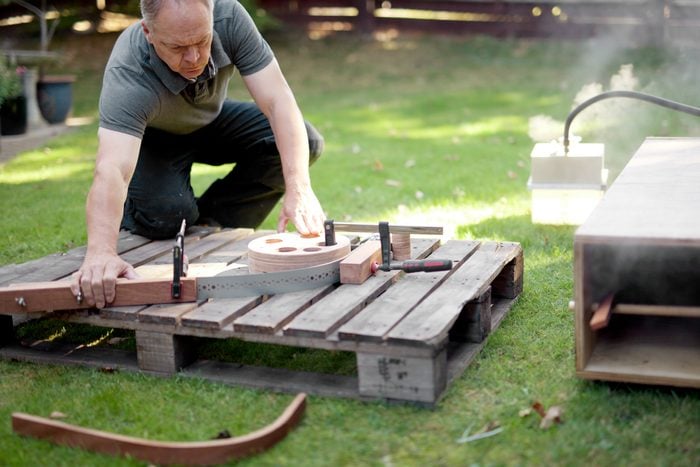Bentwood has aesthetic appeal, no doubt about it. You can use it to make ornate furniture or add some class to furniture that isn’t so ornate.
Some of the chairs at a coffee house near me feature a single bentwood brace that holds all four legs securely. It gives the appearance it was lovingly made by a master craftsperson instead of assembled at a factory, which it probably was.
Besides being attractive, bentwood is also utilitarian. Shipbuilders incorporate it into the hulls of wooden vessels. And it was a necessary component of the wings and fuselages of early aircraft, including the first practical airplane by the Wright Brothers.
Although there is more than one way to bend wood, steam bending is one of the most effective. It’s something the hobbyist can do in the woodshop as effectively as large-scale industrial producers in factories, although it does take preparation and the right equipment. If you avoid common mistakes, like trying to bend the wrong wood or hurrying the process, your chances of success are excellent.
What Is Steam Bending Wood?
Steam bending is the process of softening wood with steam until it becomes pliable enough to bend. The infusion of steam softens the wood’s lignans, the polymers that hold the cellulose fibers together. When the wood cools, the lignans harden again, and the wood holds the bent shape.
Steaming and bending are separate processes requiring equipment you can buy or build yourself. Steaming calls for a steam box, a sealed container where you place the wood and inject steam. Industrial steaming operations usually employ steel boxes that can withstand high temperatures and pressures, but most DIYers go with wood boxes.
To bend the wood, you need a form to clamp it onto. Something as simple as a large wheel would work. But if you want a particular shape, you can cut the shape into the edge of a sheet of plywood or oriented strand board (OSB) and bend the wood around it.
You also need lots of clamps. And if you’re bending sharp curves, you need bendable metal strapping to place on the outside of the wood to hold its shape.
Why Steam Bend Wood?
Using steam is one way to bend wood. Two other common techniques are kerf-cutting, which involves multiple closely-separated shallow crosscuts on the inside of the curve, and lamination, i.e. bending thin strips and gluing them together.
Although steam bending requires special equipment, it has these advantages over other methods:
- Wood grain runs continuously from end to end.
- It’s clean, eco-friendly and uses no toxic materials.
- You don’t need seasoned wood. Freshly cut green wood is easiest to bend.
- Steam-bent wood retains its shape indefinitely. There are no glue joints that can separate.
- Complex curves are easy to achieve.
How Long Does It Take To Steam Bend Wood?
Theoretically, you could complete an entire steam-bending operation in a single day. But for best results, it’s better to plan on two days.
The wood needs to be exposed to steam for at least one hour for every inch of thickness, although longer is better. And after you’ve clamped it to the form, it needs to stay there for at least the same amount of time to cool and retain its shape. Some pros recommend leaving it at least overnight.
If you don’t have a steam box, you need to buy or build one. You can buy a complete kit that includes the steamer and the pieces for building the box (assembly required).
Building a box from scratch with scrap lumber is a relatively simple project a novice can complete in a few hours. You can then generate steam with a wallpaper steamer, clothes steamer or old metal gas can, or even a large metal tea pot.
Best Wood for Steam Bending
Not all wood species are equally bendable. In general, temperate zone (domestic) hardwoods are the best, including:
- Oak (red or white);
- Elm;
- Hickory;
- Ash;
- Beech;
- Birch;
- Cherry;
- Maple;
- Walnut.
There’s dispute among woodworkers about whether softwoods are bendable, so it’s probably best to stay away from them. Similarly, most tropical hardwoods except mahogany are too dense to bend.
The wood should have as straight a grain as possible because it doesn’t bed easily around knots or circular grain. And if you have a choice between green wood and kiln dried, choose green. Kiln dried wood must absorb more steam before it becomes pliable, so the process takes longer.

How To Steam Bend Wood
Once you’ve built your steam box and hooked up the steamer, it’s important to prepare the form, assemble clamps and make all other preparations so you can work quickly when the steaming is complete.
If you’re going to round the edges of the wood with a router or do any other shaping, complete this before you start bending. It’s much more difficult to do after. Once you’re ready, the procedure is simple:
- Insert the wood in the box, seal the door and fire up the steamer. Watch the water level in the steamer and add more if necessary to ensure a steady supply of steam.
- Put on gloves, carefully remove the wood (it’ll be hot) and clamp one end to the form.
- Bend the wood around the form. You may need mechanical help, such as a come-along. Add clamps as you go, spacing them as necessary so the wood conforms to its new shape. If you’re bending around a tight radius, put metal strapping on the outside of the wood before you clamp it.
- Let the wood cool and dry overnight, then release the clamps. The wood will spring back slightly, so if you need a particular shape it’s best to over-bend it to compensate.
Article source here: Beginner’s Guide To Steam Bending Wood


No comments:
Post a Comment